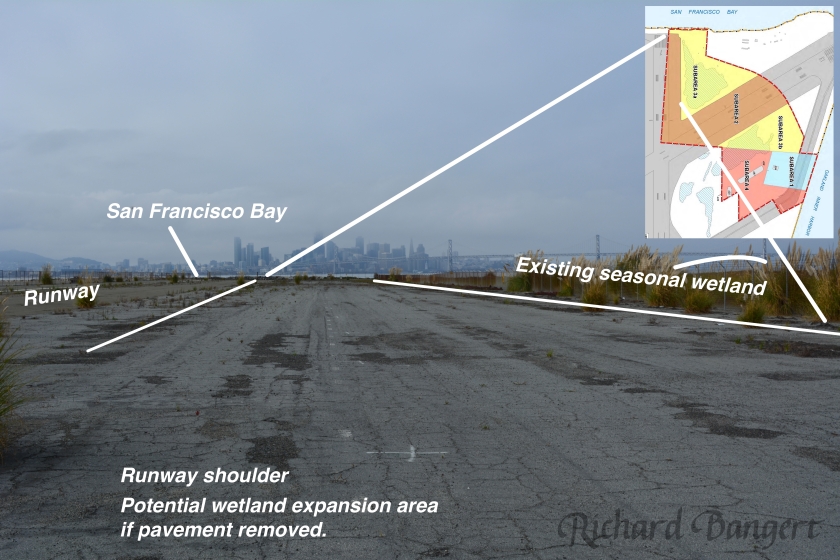The Navy will present options on possible ways to clean up 60 acres at Alameda Point slated for a regional park on Thursday night. The draft cleanup options for Site 32 represent the culmination of 25 years of groundwater and soil studies that began before base closure was announced. Only five acres have been flagged for cleanup, but uncertainty about what lies beneath the pavement and structures requires a conservative approach.
The site lies in the northwest portion of the old airfield along the Oakland Estuary and features open grassland, seasonal wetlands, runway, a large concrete bunker and two buildings. Input from the community and regulatory agencies on the cleanup plan will have a major impact on the design and use of the future park.
The most thorough of the Navy’s draft cleanup options would involve demolishing all of the structures and pavement and removing all soil to a depth of 10 feet and replacing with clean soil. This option would eliminate all future restrictions on digging and landscaping, as well as annual inspection costs. The estimated cost: $108 million.
Two less costly options are also on the table. One option would leave all of the contamination, structures, and pavement in place and cover everything except the structures with two feet of clean soil and construct new wetlands to replace those lost. The estimated cost: $21 million.
The other, and least costly, option would be to remove the soil on the five acres where contamination has been detected. All paved areas would have to remain permanently in place as a barrier for the unknowns that may lie beneath. The structures would remain but could be demolished, as long as the slabs remained in place. The estimated cost: $7.5 million.
A hybrid version of the cleanup alternatives is a possible outcome of public and regulatory input. One potential benefit of leaving the roughly 15-acre stretch of runway in place and not covering it with soil would be to provide a future site for an RV park, a skate park, or a cycling and marathon staging area.
Leaving the bunker and two buildings in place would mean they would be essentially useless hulks blocking the views. Digging up the ground to bring new utilities to the structures would be a costly can of worms, since digging would be prohibited without a complicated regulatory approval process.
Identifying contamination spots on the site was complicated by the fact that when the runway was extended over the nearby waste disposal area in 1953, site grading apparently spread contamination from the dump to surrounding areas. Some of the contamination is attributed to spills and careless handling.
Thirty treatment zones of varying size totaling five acres have been identified for either digging up and removing or covering up with clean soil. The main contaminant is radium-226 used in the painting of luminescent dials. Waste material from the radium painting operations at Alameda Point was routinely discarded in the underground dump. During the testing for radiation in the soil, 283,000 scanning measurements and 602 soil samples were collected. Radium-contaminated objects and soil areas were small. Several spots were contaminated with lead, PCBs and polycyclic aromatic hydrocarbons.

The Restoration Advisory Board meeting is Thursday at 6:30 p.m. at City Hall West (Alameda Point), 950 West Mall Square, 2nd Floor Conference Room. The public is invited.
Originally published in the Alameda Sun.











